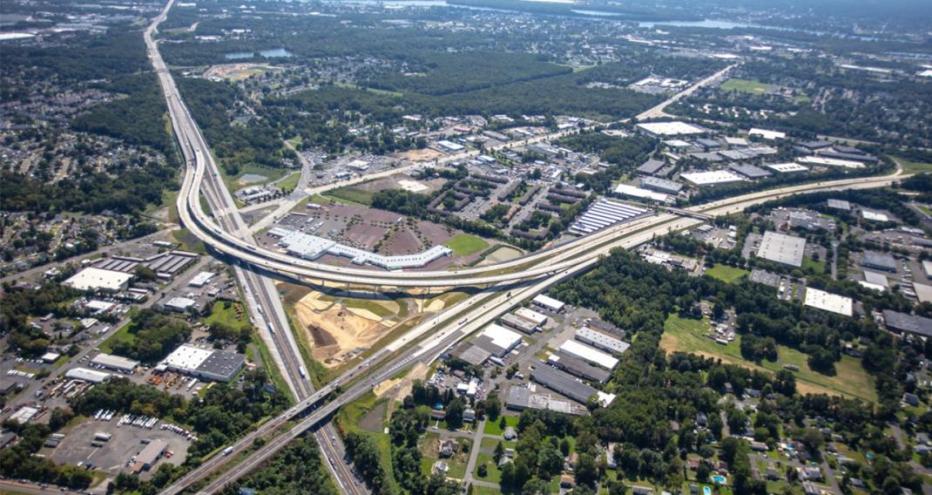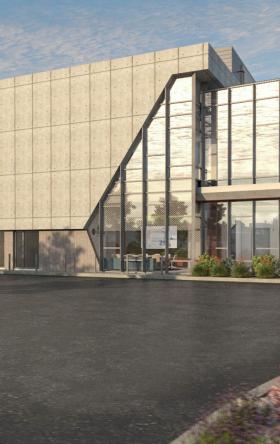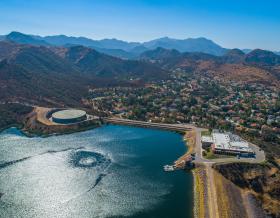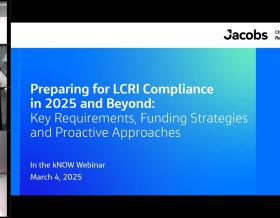
The PA Turnpike/I-95 Interchange project faced numerous challenges, including collaborative coordination amongst a large team of stakeholders and designers as well as overcoming geometric and physical constraints over its decades-long process. The lengthy duration of the conceptualization and environmental study phases – that brought together eight regional transportation agency stakeholders and over 40 design consultants – added unique challenges, such as financial constraints and updated environmental and technological guidelines and standards.
But, despite the challenges, the project team overcame these circumstances, successfully opening Stage 1 – which included the first cashless tolling point in Pennsylvania at the gateway from New Jersey, a new eastern terminus of the Pennsylvania Turnpike’s toll collection system, and the construction of twin 14 and 15 span viaducts totaling more than one mile combined.
The team – for which Jacobs serves as Program Manager, overseeing all areas of design team coordination and design reviews, an extensive public involvement campaign and monitoring the program-wide environmental and permitting commitments – continues to work toward finalizing Stages 2 and 3 to complete the project, with a renewed sense of optimism following positive feedback from motorists and Pennsylvania Turnpike customers on the opening of Stage 1. Local communities too are already reaping the benefits of enhanced connections, safer and more efficient travel – and the economic development opportunities it’s bringing to allow this largely former industrial area to compete regionally and along the Atlantic coast.
-
2
on Roads & Bridges 2020 Top 10 Roads
-
1956
date Eisenhower’s U.S. Natl Highway System was legislated
-
1 st
cashless tolling point in PA
-
8
regional transportation agency stakeholders
A Challenge Spanning Decades; Connections Made to Benefit Generations to Come
The PA Turnpike/I-95 Interchange, the centerpiece of the ultimate completion of Interstate 95 on the East Coast has posed numerous challenges for Federal Highway Administration (FHWA) and the State Transportation Agencies in Pennsylvania and New Jersey for decades,
Construction of the Pennsylvania Turnpike (I-276) was completed throughout the Mid-Atlantic region in 1956, while Interstate 95 was constructed in 1969 without a direct connection to the PA Turnpike.
This created confusion for regional travelers and resulted in increased congestion on arterials used to make the connection between the two interstates. I-95, which was often hailed as the longest north-south interstate in the country, was discontinuous for a short nearby stretch in the state of New Jersey. To address this discontinuity, the 1982 Federal Surface Transportation Assistance Act (STAA) and the 1985 Pennsylvania Act 61 named the PA Turnpike Commission as the lead agency on a project to complete I-95 using the PA and NJ Turnpikes via an interchange between I-95 and the PA Turnpike.
A Look Back
1992: Environmental Impact Studies, evaluating various alternatives and their potential impacts began
2003: Record of Decision issued
2004: Preliminary Design began
2010: Final Design interrupted; the project was evaluated and broken into three stages
- Stage 1, the first of which prioritized addressing the discontinuity of I-95, literally the final segment required to complete the entire U.S. National Highway System as originally legislated in 1956. The project’s Stage 1 components, totaling $450 million, the balance of which the Pennsylvania Turnpike Commission financed, have been mainly comprised of two of the high-speed interchange movements required to complete I-95’s missing link along the east coast. Prior to the construction of these high-speed flyover structures, however, prerequisite Stage 1 contracts included the construction of compensatory wetland, stream and threatened and endangered (T&E) mitigation sites. Additional contracts included the replacement of four overhead bridge structures to accommodate widening of the Turnpike and I-95, Intelligent Transportation Systems, construction of a new PA Turnpike mainline toll plaza serving as the new systemwide eastern tolling terminus, and the conversion of the Delaware River Bridge toll plaza to a cashless tolling facility, which was the first regional deployment of such a system.
- Stage 2 includes the replacement of the remaining overhead bridge structures to accommodate widening of the Turnpike mainline, reconstruction and widening of portions of the interstates, and construction of the remaining six ramps to fully connect the interstates.
- Stage 3 will involve the replacement of the Delaware River Bridge to provide additional traffic capacity and mainline improvements on the bridge approaches in PA and NJ.
Collaboration is Key
The PA Turnpike Commission has worked cooperatively with the FHWA’s Pennsylvania Division and the Pennsylvania Department of Transportation (PennDOT) in the design and construction of Stage 1 of the Project.
Coordinating Agencies include the FHWA’s New Jersey Division, the New Jersey Department of Transportation (NJDOT), the New Jersey Turnpike Authority (NJTA), the Delaware River Joint Toll Bridge Commission (DRJTBC) and the Delaware Valley Regional Planning Commission (DVRPC).
Technological Hurdles
Beyond the extensive coordination amongst the agencies during design and construction, additional collaboration between the PA Turnpike Commission and PennDOT was required to generate agreements related to ownership and maintenance as well as data sharing to monitor the highways and inform motorists and emergency responders of varying conditions. The data sharing proved to be especially challenging since both agencies have unique transportation software platforms, which have evolved technologically throughout the design process, spanning over a decade. Contract special provisions have detailed construction of the ITS infrastructure and establishment of fiber networks, implementation of ITS devices, testing of those devices and integration of data to ensure that both agencies are able to access and collect the data and camera images.
“The PA Turnpike is proud to have led the efforts to complete Stage 1 of this challenging program which completes I-95 and the originally legislated U.S. Interstate Highway network. The talented group of professionals involved, including our state and federal partners, who worked together as a true team, were creative and dedicated, all while exhibiting sensitivity to the surrounding environment and communities.”
Innovative Solutions During Construction
Innovative construction techniques were implemented in order to overcome the challenges associated with maintaining live traffic along the two heavily traveled interstates involved in this project. In order to relocate an existing unnamed stream adjacent to Eastbound I-276 (PA Turnpike), a new 136’ long precast reinforced concrete box culvert (8’x7’) structure was jacked under live PA Turnpike traffic during a continuous operation. Similarly, live traffic was maintained along I-95 while a bypass pumping operation, maintaining 7 MGD sewer water flow, took place. Beyond this bypass pumping, the 24” pipe was also extended on both sides of I-95 with a 36” concrete pipe inside a 60” steel casing.
The designers were challenged by a number of geometric constraints during the design of the interchange Northbound and Southbound flyover structures, 14 span and 15 span viaducts totaling 3808 linear feet and 2488 linear feet, respectively. Utilizing Integral Pier Caps minimized the length of the flyover ramp approaches by lowering of the roadway profiles. The two (2) integral piers on the PA Turnpike required construction of massive steel frames to support the loads of the structural steel girders, while forming the pier cap around the steel girders which were then encased within the pier cap concrete. PVC conduit was fed horizontally through the pier cap, and wire strands were pulled through the conduit allowing the strands to be post-tensioned after the cap was poured. The wire strands inside the conduit were locked off and grouted once the tensile strength criteria were met.
Installing Stormwater Infrastructure to Satisfy Updated Guidelines
When the Pennsylvania Turnpike was constructed in the 1950s, there was little guidance on stormwater management practices/infrastructure. As such, the interstate was constructed and stormwater runoff was conveyed off the turnpike mainline, essentially creating swales adjacent to the roadway. Fifty years later, as a focus on stormwater management and resultant updated regulations from environmental agencies evolved, the project team was challenged to design infrastructure in line with stricter guidelines, while also mitigating impacts to wetlands and resources created by decades of established stormwater conveyance. These mitigation efforts are referenced above as a prerequisite, regulatory construction phase.
Redesignating a Geometrically Unique Configuration, Then Informing Regular Motorists
The 1980s legislation mandated the rerouting of I-95 along the PA and NJ Turnpikes, which also necessitated the redesignation of a portion (approximately 20 miles) of what was originally designated as I-95 in PA and NJ. The original segment of I-95 to be redesignated, however, was not a strict north/south or east/west configuration, rather it was circuitous in nature. As such, the project team made the determination to redesignate the segment as I-295, an even-numbered route to categorize the segment as a loop/beltway connected with I-95 and both termini. AASHTO’s Special Committee on US Route Numbering approved the seven (7) applications (portions of I-95, I-295 and I-276 were all involved) submitted on behalf of PA and NJ recommending the chosen scheme.
A year before the signing changes were scheduled to take place, representatives from the project team and seven cooperative and coordinating agencies, convened for monthly meetings focused on Public Information and Agency Operational changes. A redesignation-specific website (www.i95link.com) was created to disseminate information/schedule updates and provide a page for submittal of public questions related to the redesignation. Additionally, radio and billboard advertisements and interviews with the local news media were utilized to provide as much information as possible during the phased re-signing effort, involving new signs, sign overlay panels and exit number changes.












































